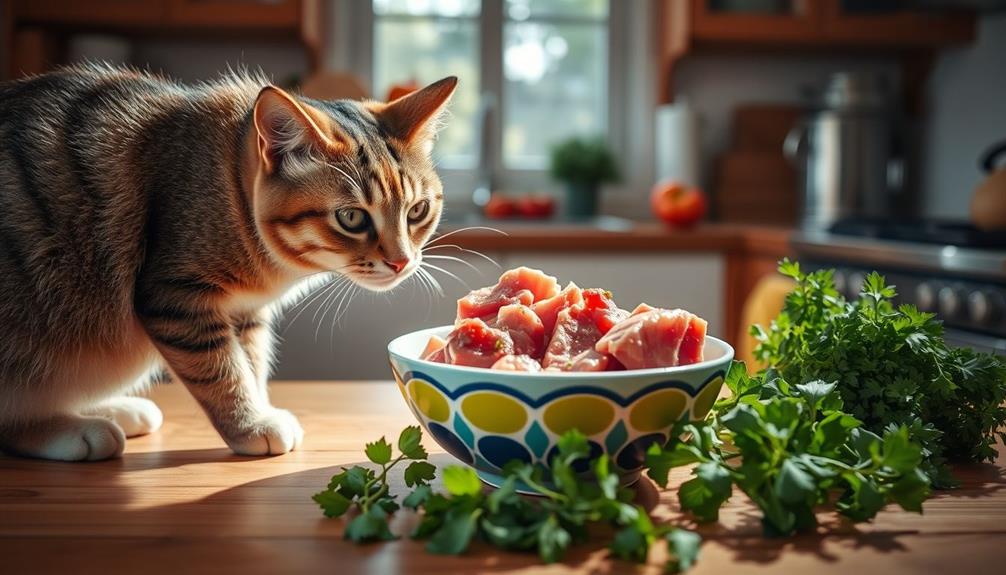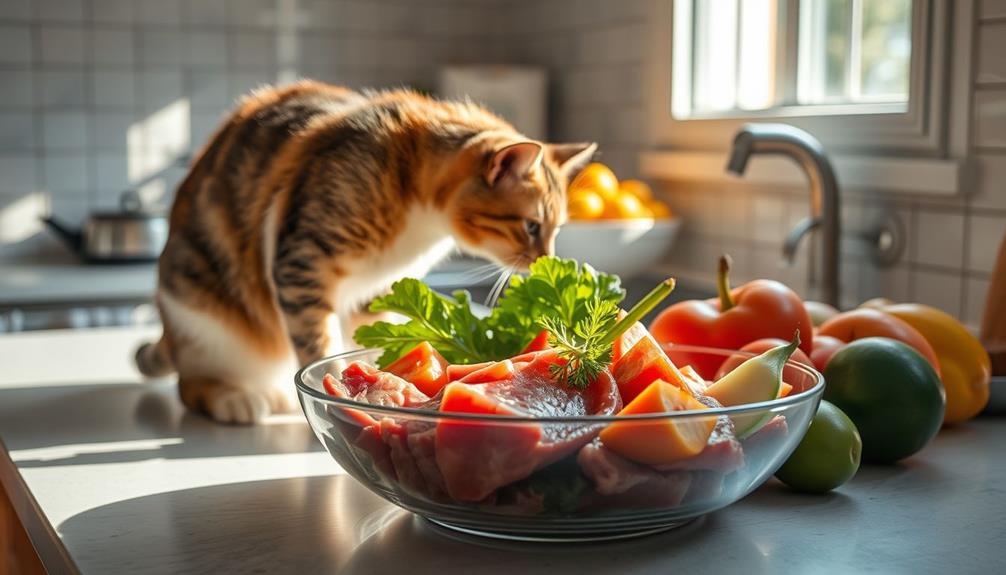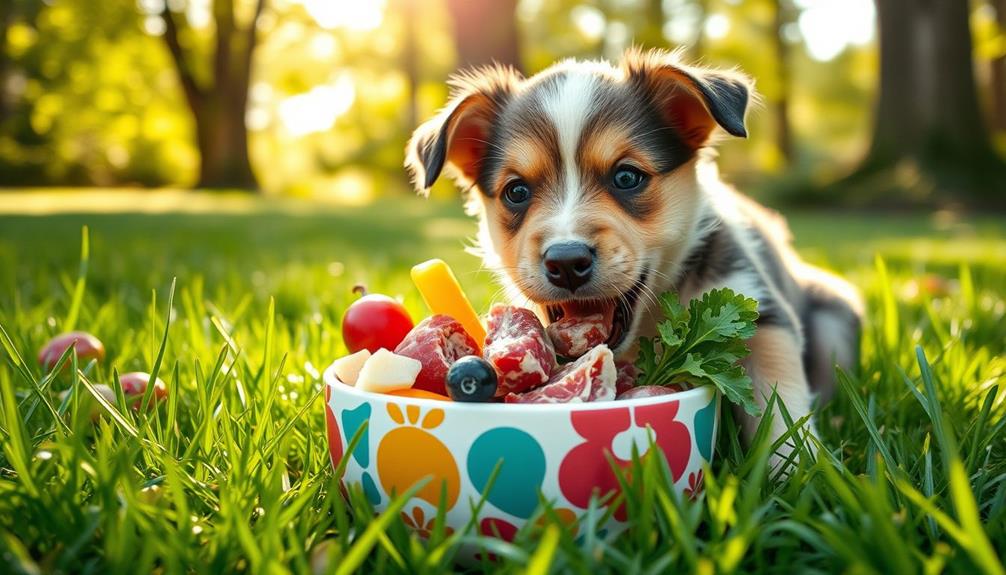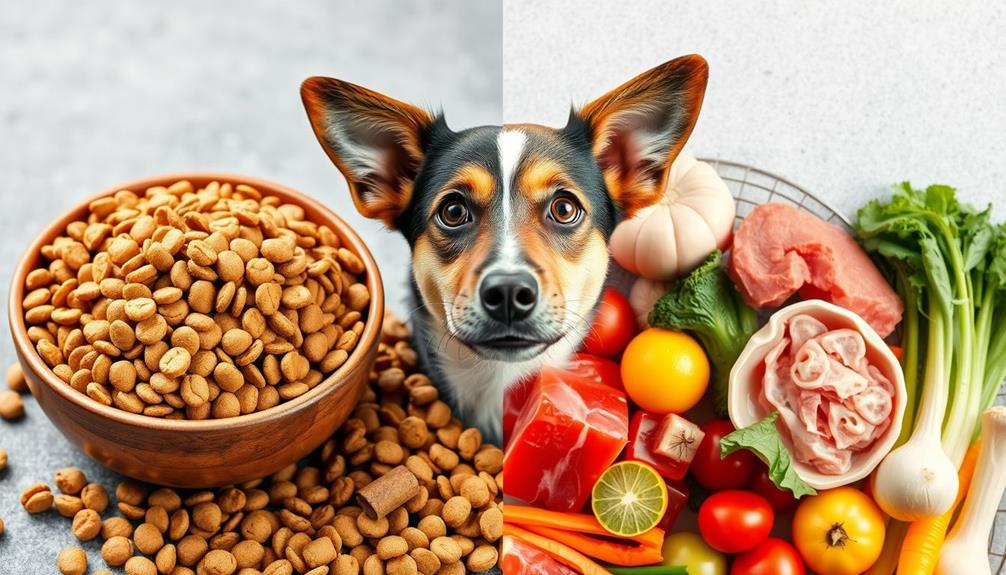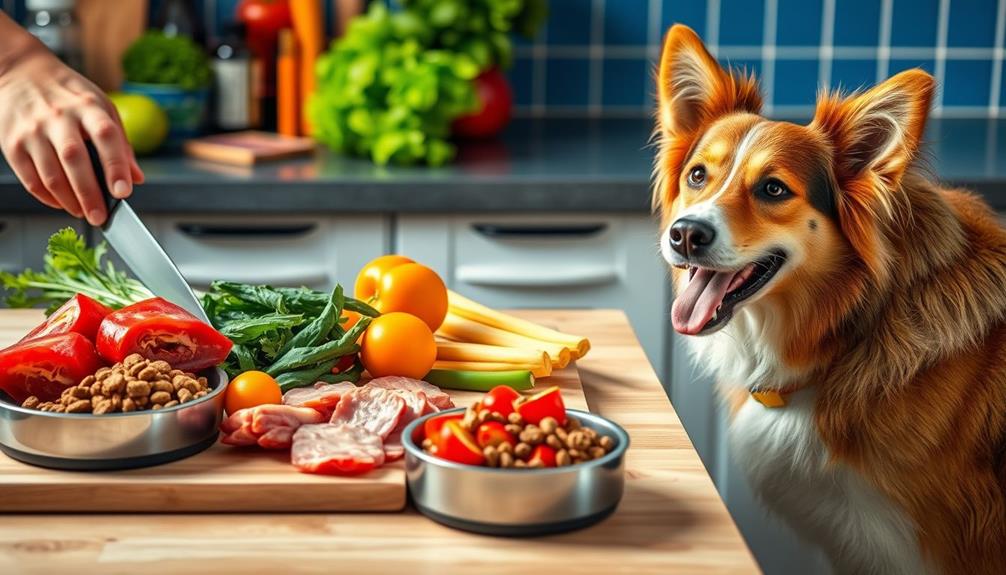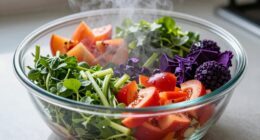To get your cat to eat raw food, start by gradually mixing a small amount of raw with their regular diet. This helps them recognize new scents and textures. Try using toppings like bonito flakes to entice them. Engage their hunting instincts by hiding small portions of raw food around the house or smearing it on their paws for exploration. Limit meal frequencies to increase appetite, and always offer food at room temperature to enhance aroma. These tips can make the shift smoother, and you'll discover more effective techniques as you experiment with what's best for your feline friend.
Key Takeaways
- Gradually mix raw food with familiar wet food to ease the transition and enhance acceptance of new flavors and textures.
- Use enticing toppings like bonito flakes or powdered liver to stimulate interest and encourage initial bites of raw food.
- Engage your cat's hunting instincts by hiding small portions of raw food and providing a variety of textures.
- Monitor your cat's response and adjust meal frequency and ratios to ensure they are comfortable with the new diet.
- Warm raw food to room temperature to enhance aroma and make it more appealing for your cat to eat.
Understanding Feline Eating Behavior
When you're trying to introduce raw food to your cat, it's essential to understand their unique eating behavior. Cats are imprint eaters, meaning they primarily recognize food by smell, texture, taste, and temperature.
If your cat refuses to eat the new raw food diet, it mightn't be due to pickiness but rather a lack of recognition. After being fed the same diet for a long time, they may need time to adapt to different flavors and textures. Incorporating healthy dog snacks for your pets can also provide insights into how different textures and flavors influence feeding habits.
To ease the shift, consistently offer the new food alongside their regular meals. This helps them gradually recognize the new food as a part of their feeding behavior.
Additionally, whisker fatigue can hinder their eating; if your cat struggles with deep bowls, consider switching to shallow dishes or plates.
Start introducing a variety of foods during their early life stages to promote adaptability as adults. By being mindful of these aspects, you can create a more positive experience for your cat, making it easier for them to embrace their new raw food diet.
Importance of Motivation

Understanding the importance of motivation can greatly ease the change to a raw food diet for your cat. Identifying your personal reasons for shifting to raw, like improved health or natural feeding, creates a strong foundation for this journey.
If you recognize potential health issues linked to your cat's current kibble diet, it can further reinforce the need for dietary changes. Additionally, considering the benefits of a varied diet can enhance your cat's overall well-being, as it prevents selective eating habits and encourages a healthier lifestyle, similar to how a gout-friendly diet can improve overall health.
Staying motivated through challenges is essential; shifting to raw can take time, especially for older or picky eaters. Keep reminding yourself of the benefits of a diet free from synthetic supplements, which can help maintain your focus on long-term health goals for your cat.
Reflecting on the importance of a varied diet can also spark motivation. A diverse diet not only prevents selective eating habits but also enhances your cat's overall quality of life.
Preparing for Raw Feeding
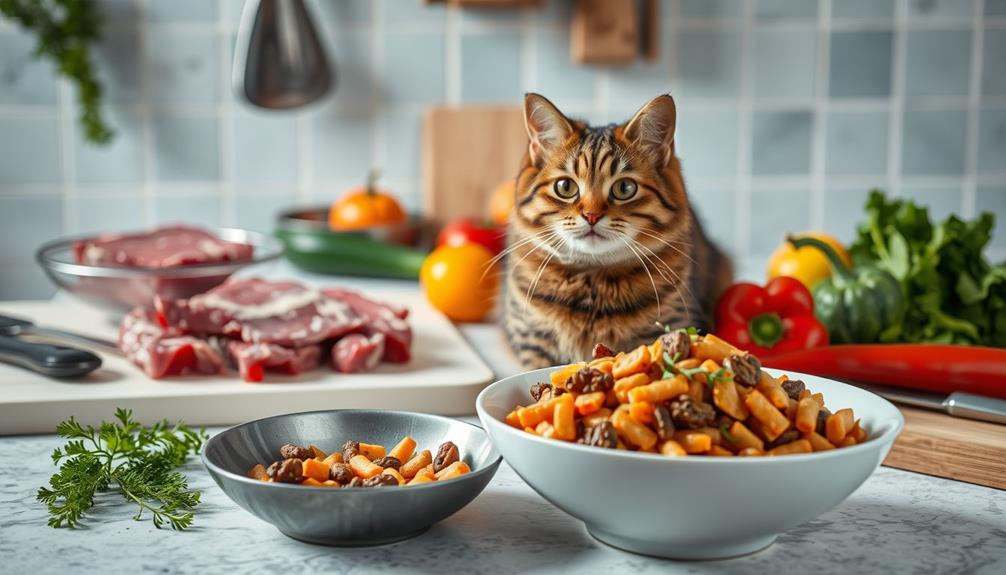
Shifting to a raw food diet for your cat requires careful preparation to guarantee a smooth and successful alteration. To make sure you're ready for shifting, follow these essential steps:
1. Gather Utensils: Get a knife, cutting board, and scale for proper preparation and portioning of the raw food.
2. Source Quality Ingredients: Stock up on high-quality meat and other ingredients to create a balanced diet that meets your cat's nutritional needs.
It's also beneficial to explore hamster care and costs to understand the importance of budgeting for pet diets.
3. Join Raw Feeding Groups: Connect with local raw feeding communities for tips, support, and resource sharing. You'll find invaluable advice from fellow cat owners.
4. Budget Accordingly: Assess your budget for ongoing raw feeding costs, as prices for meat and ingredients can vary widely.
When calculating how much to feed your cat, aim for approximately 4 ounces per day for adult cats, adjusting based on their weight and dietary requirements.
Remember, the shift from canned food texture to raw food might take some time, so be patient.
Transitioning Methods
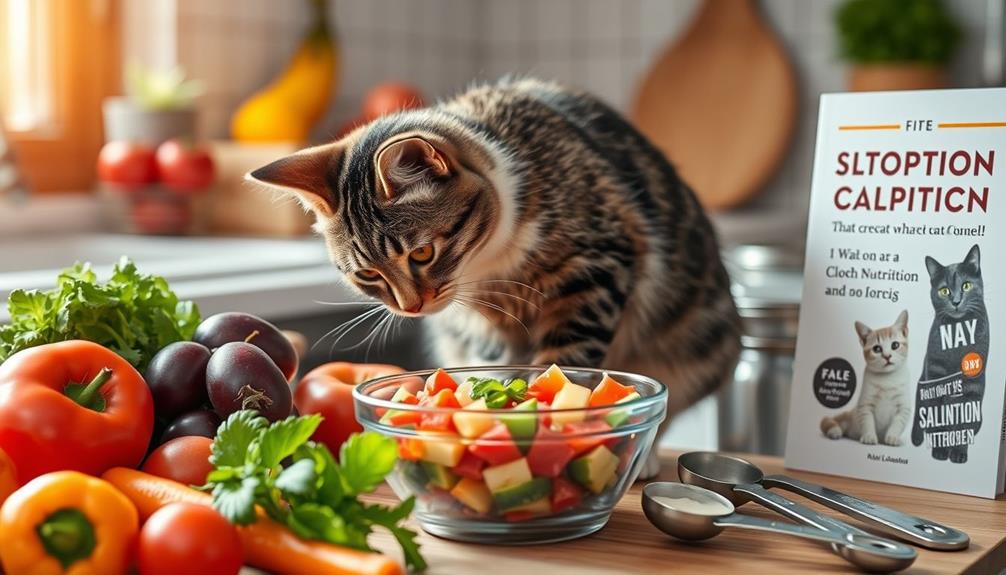
When shifting your cat to raw food, start by gradually mixing small amounts with their current diet. This method not only eases them into the change but also engages their natural hunting instincts, making the process more appealing.
For instance, young pets often display silly behaviors during meal times, reminiscent of silly tantrums during family photoshoots.
Remember to be patient and observe their reactions as you adjust the ratios.
Gradual Food Mixing
Changing your cat to a raw food diet can be a smooth process if you take it step by step. Gradual food mixing is key, allowing your cat to adapt without stress. This method can help avoid potential pitfalls like financial mistakes to avoid when it comes to budgeting for pet care.
Here's how to do it effectively:
- Start with Canned Food: Begin by mixing 10% canned food with their current kibble. This introduces new flavors while keeping things familiar.
- Increase Gradually: Over the next few days, slowly increase the canned food ratio. This helps your cat's digestive system adjust before you shift to raw.
- Incorporate Raw Food: Once your cat accepts the canned food, start mixing the raw food. Use a similar gradual ratio approach, perhaps starting with 10% raw mixed with 90% canned.
- Monitor and Adjust: Keep an eye on your cat's response. If they seem to struggle, adjust the ratios to guarantee they maintain a healthy diet.
Using natural canned food without additives is vital during this shift.
With patience and careful mixing, your cat can enjoy a healthier, raw food diet!
Engage Hunting Instincts
Engaging your cat's hunting instincts can make the change to a raw food diet more appealing and natural. Start by hiding small portions of raw food around your home. This stimulates their natural hunting behavior, encouraging them to explore and engage with their food as they'd in the wild.
Consider using essential oils for relaxation to create a calm environment that may help your cat feel more at ease during the change.
To further mimic the experience of hunting, offer a variety of textures and shapes in the raw food. This variety can entice your cat to try new offerings.
Incorporating playtime before meals can also increase their hunger and interest in raw food, making acceptance much easier.
Another effective method is smearing raw food on your cat's paws. This playful approach promotes licking and exploration, helping them acclimate to the new taste and texture.
You can also introduce raw food that resembles prey, such as whole small items or parts. This method appeals to your cat's instincts and increases their willingness to give it a try.
Strategies for Picky Eaters
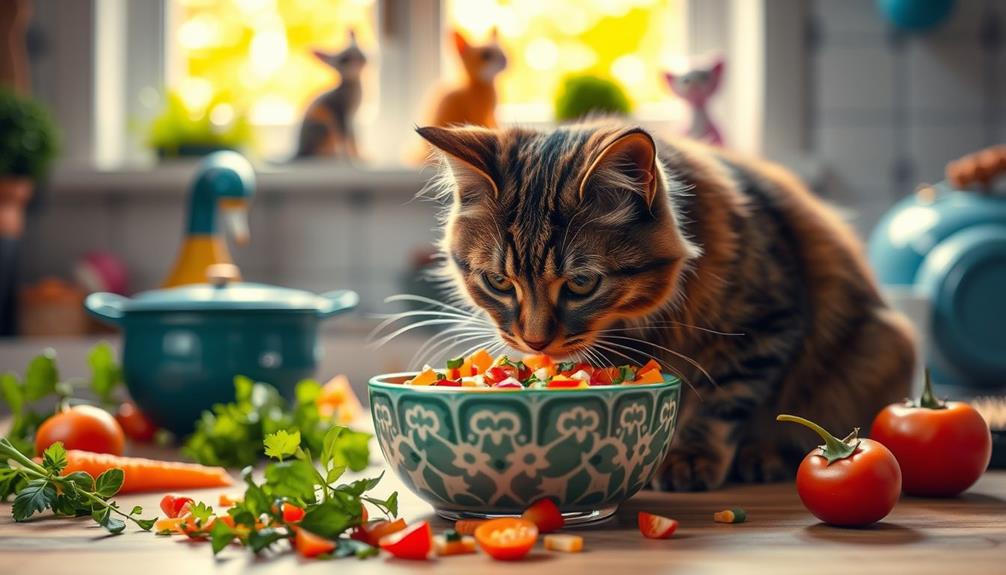
If your cat's a picky eater, adjusting their meal frequency can make a big difference.
Consider consulting with your veterinarian about medication management for seniors to guarantee there are no underlying health issues affecting their appetite.
Try offering food 2-3 times a day and consider using enticing toppings to spark their interest.
Gradually mix raw food with their favorite wet food to help them adjust to new textures and flavors.
Meal Frequency Adjustment
Adjusting your cat's meal frequency can make a big difference in their eating habits, especially for picky eaters. Shifting from free feeding to scheduled meals encourages your picky cat to eat what's offered rather than graze throughout the day.
Understanding the importance of coffee brewing methods can be akin to recognizing the nuances of feline feeding habits. Here are some strategies for meal frequency adjustment:
- Limit Meals: Serve meals 2-3 times daily instead of leaving food out all day. This can stimulate their appetite.
- Start with Canned Food: Use high-quality, grain-free canned food to entice your cat and help them accept new textures before you introduce raw food.
- Gradual Introduction: Mix raw food with their favorite wet food. This familiarizes them with new scents and textures, making the shift to raw less intimidating.
- Observe and Adjust: Pay attention to your cat's reactions and adjust meal sizes and frequency as needed to find what works best for them.
Enticing Toppings Usage
Transform your cat's mealtime experience by adding enticing toppings to their raw food. These toppings can greatly enhance the flavor and aroma, making the raw food more appealing to even the pickiest eaters. For instance, you might consider incorporating toppings that are rich in antioxidants or vitamins, similar to how celery juice offers health benefits for overall well-being.
Try using baby food, freeze-dried treats, or bonito flakes—these are sure to stimulate your cat's appetite.
Another effective strategy is to sprinkle powdered liver or parmesan cheese on top of the raw food. This simple addition can coax your cat to take that first bite.
Don't hesitate to experiment with different toppings to discover what your cat likes best; every cat has unique preferences.
If your cat seems hesitant, consider adding in a little high-quality, grain-free canned food mixed with the raw food. This method can help familiarize them with raw ingredients and ease the shift to raw.
Lastly, maintain a consistent meal presentation and incorporate those enticing toppings during scheduled feeding times. Over time, this practice can reinforce positive eating habits and increase the likelihood of your cat accepting raw food as a regular part of their diet.
Gradual Food Mixing
Introducing raw food to a picky eater can be a challenge, but using a gradual mixing strategy can make the change smoother. Start with high-quality, grain-free canned food mixed with kibble to help your cat get used to new textures and flavors. Incorporating herbal teas like chamomile to promote relaxation during feeding times may also help ease the shift.
Here's how to do it:
- Begin with a 10% canned food to 90% kibble ratio. This helps your cat adjust without overwhelming them.
- Once your cat accepts the canned food, move on to adding raw food. Maintain a similar ratio of 10% raw to 90% canned to ease them into the new diet.
- Incorporate enticing toppings like fish bits or bonito flakes on the raw food. This can stimulate interest and encourage your cat to eat.
- Monitor your cat's response and adjust the ratios as needed. If your cat resists, try mixing small amounts of raw food into their favorite wet food, gradually increasing the raw component while checking for any digestive issues.
Monitoring Dietary Adjustments
When shifting your cat to a raw food diet, keeping a close eye on their dietary adjustments is vital for their health and well-being.
Start by regularly monitoring your cat's stool consistency. Loose stools may suggest that you need to increase the bone content, while firm, crumbly stools might indicate a need to reduce bone and add more organ meat.
It's also a good idea to keep a feeding log. This helps track your cat's acceptance of new foods and any changes in behavior or health.
Observing your cat's weight is important; make sure they aren't losing or gaining excessive weight, as these fluctuations can signal a dietary imbalance.
Adjust the ratios of muscle meat, bone, and organ meat based on your cat's responses and stool observations. This guarantees you maintain ideal digestive health and nutritional needs.
If you notice any significant changes in appetite or signs of digestive distress, consult with a veterinarian for guidance.
Your cat's health is your top priority during these dietary adjustments, so stay attentive and proactive in monitoring their progress.
Tips for Smooth Transition
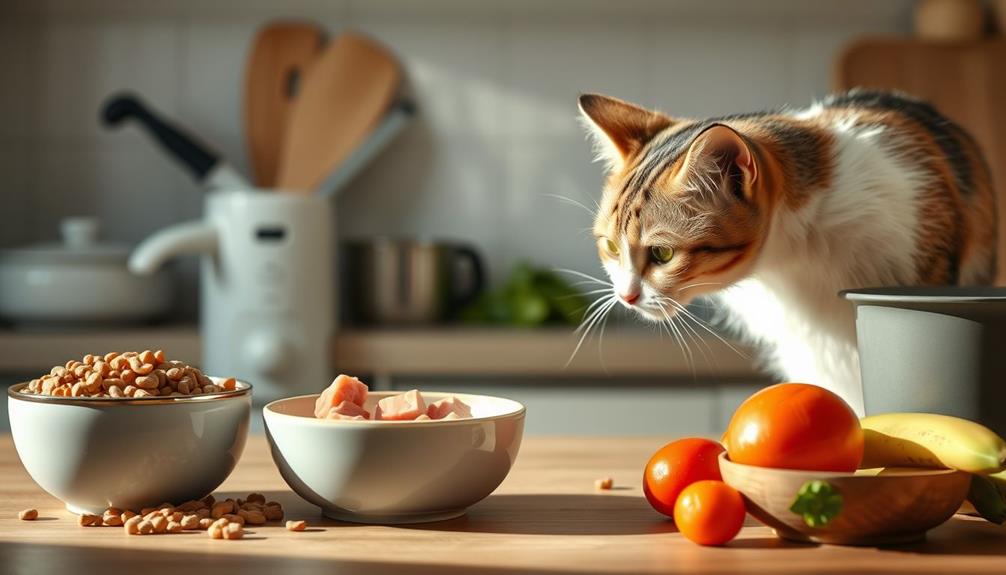
To help your cat smoothly shift to raw food, start by gradually mixing it with their current diet.
Engage their interest with creative feeding techniques while keeping an eye on their health progress.
This way, you can guarantee they adapt well and enjoy their new meals.
Gradual Food Mixing
A smooth shift to raw food for your cat can be achieved through gradual food mixing. Start by introducing a small amount of raw food—about 10%—with your cat's current food, like kibble. This allows your cat to acclimate to the new texture and flavor.
Over several days or weeks, increase the raw food proportion while decreasing the kibble, always keeping an eye on how your cat responds.
Here's a simple approach to effective gradual food mixing:
- Begin with 10% raw food mixed into the current kibble.
- Observe your cat's reaction and adjust the amount based on their preference and tolerance.
- Incorporate high-quality canned food as an intermediary step, mixing it with kibble to enhance familiarity.
- Monitor stool consistency; loose stools may mean adding more bone content, while firm stools suggest more organ meats are needed.
Engaging Feeding Techniques
After you've gradually mixed raw food with your cat's kibble, engaging feeding techniques can further encourage them to embrace this new diet.
One effective method is smearing raw food on your cat's front paws. This encourages them to lick it off, allowing them to familiarize themselves with the new taste and texture. You can also enhance the appeal of raw food by using flavor toppers, like bonito flakes or powdered liver, which can entice your cat to give it a try.
Mixing water with kibble before introducing raw food can make the shift smoother and more palatable. Additionally, hiding raw food in various locations around your home can stimulate your cat's hunting instincts, making them more inclined to seek it out and eat it.
Don't forget about the bowl design. Choosing lower-rimmed or wide plates can help prevent whisker fatigue, making it easier for your cat to access their food.
Implementing these engaging feeding techniques can make the shift to raw food not only smoother but also more enjoyable for your furry friend.
Monitoring Health Progress
Monitoring your cat's health during the change to raw food is essential for guaranteeing a successful and safe dietary alteration.
To make this shift smoother, keep an eye on the following key factors:
- Weight: Regularly weigh your cat to guarantee they're maintaining a healthy body condition. Look out for any excessive weight loss or gain during the change.
- Appetite: Track your cat's appetite and eating habits closely. If you notice a decrease in food intake or persistent refusal of the new raw food, it may be time to adjust your approach.
- Stool Consistency: Observe your cat's stool. Loose stools might indicate they need more bone content, while firm, crumbly stools suggest a need for more organ meat and less bone.
- Digestive Issues: Watch for any signs of digestive distress, like vomiting or diarrhea. If these issues persist, consult your veterinarian, as they could point to dietary imbalances.
Troubleshooting Common Challenges
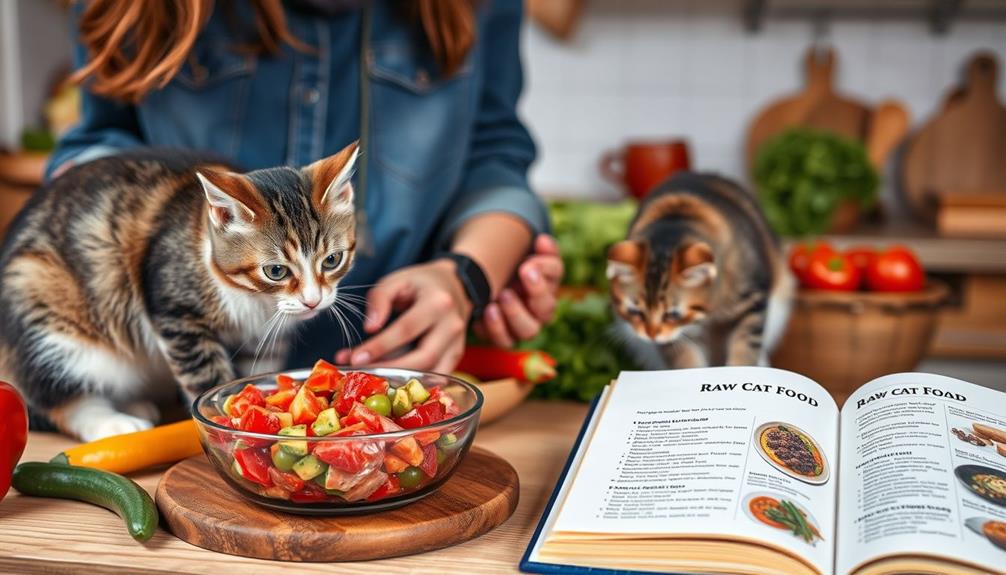
When shifting your cat to a raw food diet, you may encounter several challenges that can hinder their acceptance. If your cat goes on a hunger strike, try warming the food to room temperature to enhance its aroma. Additionally, you can engage your cat with dried raw food during playtime, creating a positive association with the new diet. Smearing a small amount of raw food on your cat's paws can also encourage licking, but limit this to avoid irritation.
It's essential to monitor your cat's behavior and appetite closely. If they refuse to eat for more than two days, revert to their old food, gradually mixing it with the new diet. While doing this, keep an eye on your cat's body weight daily to make certain they remain healthy. Celebrate small successes by incorporating variety in raw food offerings to maintain interest and prevent boredom.
Here's a quick reference table for troubleshooting:
| Challenge | Solution | Tips |
|---|---|---|
| Hunger strike | Warm food | Add water for moisture |
| Refusal to eat | Engage in play | Monitor behavior |
| Limited interest | Mix with old food | Vary food options |
| Eating too slowly | Smear on paws | Limit smearing |
| Weight concerns | Monitor body weight daily | Consult a vet if needed |
Benefits of a Raw Diet
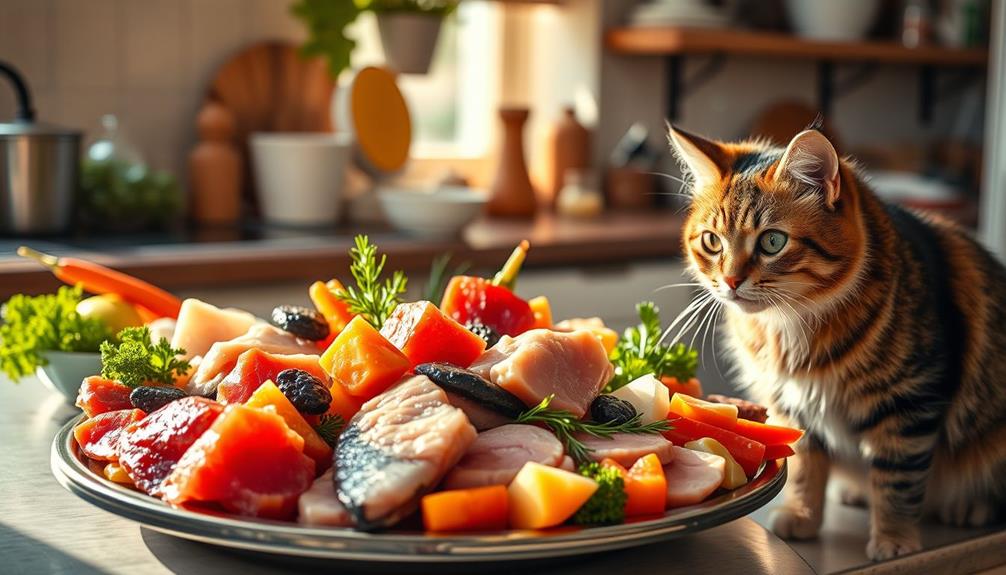
Successfully overcoming the challenges of introducing a raw food diet can lead to numerous benefits for your cat's health and well-being. Here are some key advantages you can expect from a raw diet:
- Higher protein levels: Raw food provides the essential protein your cat needs to maintain muscle mass and energy levels, supporting their obligate carnivore status.
- Omega-3 fatty acids: Fresh meat in a raw diet is rich in omega-3 fatty acids, which promote healthier skin and a shiny coat, often lacking in commercial kibble.
- Urinary tract health: The natural moisture content in raw food helps prevent dehydration, reducing the risk of concentrated urine and urinary tract infections.
- Dental health: Incorporating raw meaty bones can naturally clean your cat's teeth and exercise their jaw muscles, considerably reducing plaque buildup.
A balanced raw diet guarantees your cat receives essential nutrients, including taurine, crucial for heart and eye health.
Long-term Health Considerations
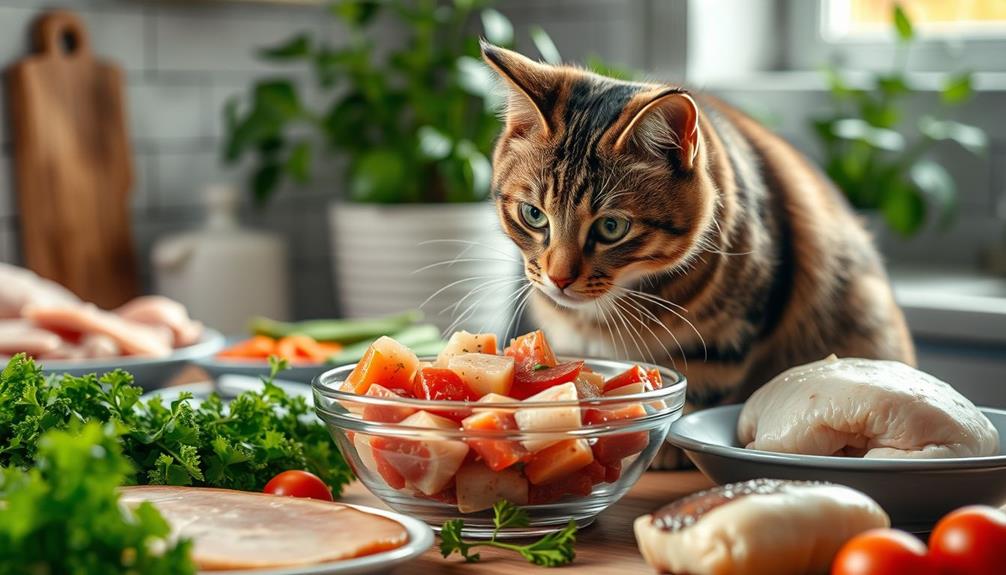
Over time, maintaining a balanced raw diet for your cat can greatly impact their long-term health. A well-planned cat raw diet helps prevent nutritional deficiencies that often arise from commercial foods, which may lack essential omega-3 fatty acids important for skin and coat health.
It's essential to guarantee your cat gets adequate protein sources and taurine, an essential amino acid they can't synthesize. Insufficient taurine can lead to serious health issues like heart disease and vision problems.
Incorporating raw meaty bones into your cat's meals not only supports dental health but also encourages healthy chewing habits and provides mental stimulation.
As you shift to this diet, monitoring stool consistency is key. By observing stool firmness or looseness, you can assess the diet's adequacy and make necessary adjustments to optimize digestive health.
Frequently Asked Questions
How Do I Get My Cat to Eat Raw Food?
To get your cat to eat raw food, start by mixing a small amount with their current diet. Use enticing flavor toppers, smear it on their paws, and establish a consistent feeding schedule to encourage acceptance. Transitioning your cat to raw food may take some time and patience, as some cats can be resistant to change. Be sure to monitor their reaction to the new diet and consult with a veterinarian if you have any concerns. Slowly increasing the amount of raw food in their diet while decreasing the amount of their current food can help ease the transition process.
Why Won't My Cat Eat Raw Food?
Your cat might not eat raw food because it's unfamiliar or your cat's experiencing whisker fatigue. Try mixing it with familiar foods, using shallow bowls, or engaging in play to stimulate its appetite before mealtime.
How Can I Make Raw Cat Food Taste Better?
To make raw cat food taste better, try mixing in enticing toppers like bonito flakes, warming it to room temperature, or smearing it on your cat's paws to encourage their natural grooming instincts.
How Do You Tempt a Cat That Won't Eat?
When your cat turns up its nose, think of it like a stubborn artist. Try warming the food, mixing in tasty toppers, or hiding it to spark their curiosity and coax them into eating.
Conclusion
In the end, getting your cat to eat raw food can be a game changer for their health. By understanding their behavior and using the right strategies, you can make the shift smoother than a well-oiled machine. Stay patient and keep experimenting with different flavors and textures. Remember, Rome wasn't built in a day, so take your time and celebrate small victories. With dedication, you'll help your feline thrive on a nutritious raw diet, and that's the cat's pajamas!

